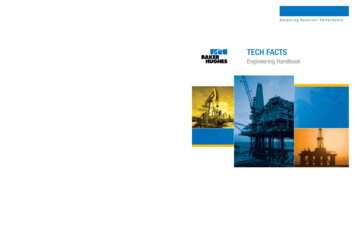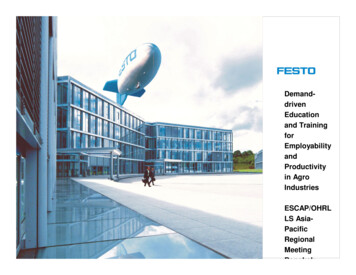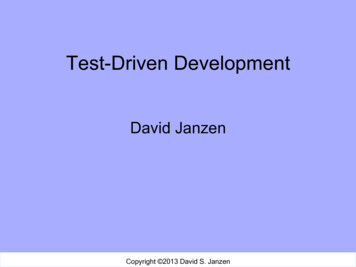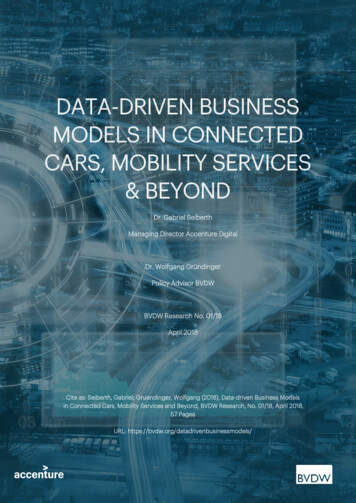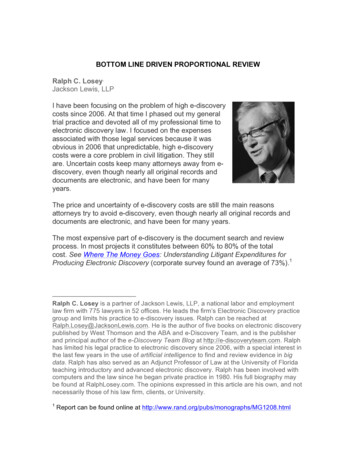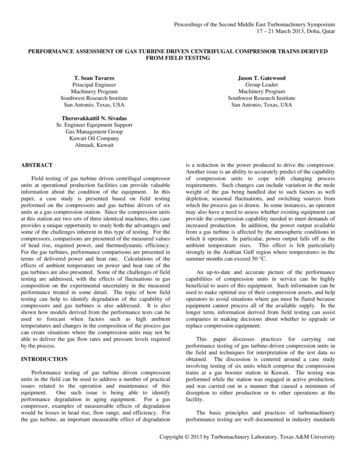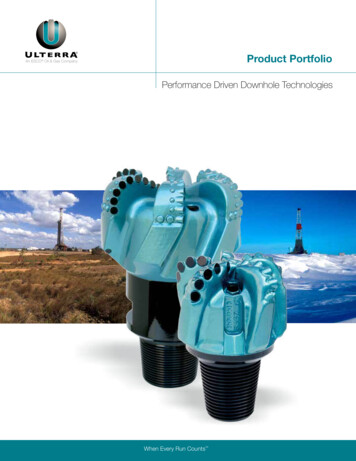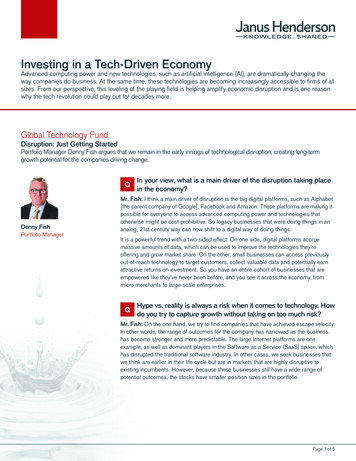
Transcription
Investing in a Tech-Driven EconomyAdvanced computing power and new technologies, such as artificial intelligence (AI), are dramatically changing theway companies do business. At the same time, these technologies are becoming increasingly accessible to firms of allsizes. From our perspective, this leveling of the playing field is helping amplify economic disruption and is one reasonwhy the tech revolution could play out for decades more.Global Technology FundDisruption: Just Getting StartedPortfolio Manager Denny Fish argues that we remain in the early innings of technological disruption, creating long-termgrowth potential for the companies driving change.QDenny FishPortfolio ManagerIn your view, what is a main driver of the disruption taking placein the economy?Mr. Fish: I think a main driver of disruption is the big digital platforms, such as Alphabet[the parent company of Google], Facebook and Amazon. These platforms are making itpossible for everyone to access advanced computing power and technologies thatotherwise might be cost-prohibitive. So legacy businesses that were doing things in ananalog, 21st-century way can now shift to a digital way of doing things.It is a powerful trend with a two-sided effect: On one side, digital platforms accruemassive amounts of data, which can be used to improve the technologies they’reoffering and grow market share. On the other, small businesses can access previouslyout-of-reach technology to target customers, collect valuable data and potentially earnattractive returns on investment. So you have an entire cohort of businesses that areempowered like they’ve never been before, and you see it across the economy, frommicro merchants to large-scale enterprises.QHype vs. reality is always a risk when it comes to technology. Howdo you try to capture growth without taking on too much risk?Mr. Fish: On the one hand, we try to find companies that have achieved escape velocity.In other words, the range of outcomes for the company has narrowed as the businesshas become stronger and more predictable. The large Internet platforms are oneexample, as well as dominant players in the Software as a Service (SaaS) space, whichhas disrupted the traditional software industry. In other cases, we seek businesses thatwe think are earlier in their life cycle but are in markets that are highly disruptive toexisting incumbents. However, because these businesses still have a wide range ofpotential outcomes, the stocks have smaller position sizes in the portfolio.Page 1 of 5
Investing in a Tech-Driven EconomyYou have an entirecohort of businessesthat are empoweredlike they’ve never beenbefore, and you see itacross the economy,from micro merchants tolarge-scale enterprises.”QTech stocks have outperformed the broader market in recentyears. What has that done to valuations, and do we riskrepeating the 1990s tech bubble?Mr. Fish: In the 1990s, tech stocks traded on the theory that the information age wouldtake over and digitize the economy. But the reality wasn’t there yet, and the marketoverpriced it. Now, 20 years later, digitization is finally happening, but this time we thinkthe market is underpricing the potential impact that tech will have on all facets of theeconomy. The financial performance of tech companies today is incredibly strong,resulting in valuations that are nowhere near what they were during the tech bubble.And while it’s true that multiples have climbed along with the rest of the market,compared to some other sectors, tech’s performance has been more balanced betweenearnings growth and multiple expansion.QWhat is one example of this potential that the market could beoverlooking?Mr. Fish: I think we are at the start of a decade or two of accelerated growth forsemiconductors, driven by the Internet of Things, cloud computing and AI. A lot ofdevices that didn’t use to have semiconductors or connectivity – say, your refrigeratorand car – now have them. These items collect data and feed that data to the cloud,where it is analyzed and used to make devices smarter. With the advent of AI and 5Gconnectivity, this trend is only likely to accelerate. So we’re talking about a staggeringexplosion in the number of semiconductors needed, but, based on valuations, themarket seems to be overlooking it.Of course, semiconductors are a cyclical industry, so investors should expect downcycles. But relative to history, we believe the magnitude of those cycles could be lessamplified given the industry’s diversification into new end markets such as automotive,industrials and medical. The product cycle booms and busts for personal computersand smartphones will likely have less of an impact.Page 2 of 5
Investing in a Tech-Driven EconomyForty FundThe Network EffectThe democratization of computing power is enabling companies to interact directly with consumers. That, saysPortfolio Manager Doug Rao, can lead to powerful competitive advantages for businesses.QDoug RaoPortfolio ManagerOnce that relationship[with a customer] is inplace, companies tendto be better able toextend their platformsand sell additionalproducts and services.”From your perspective, what is one of the most important driversof the disruption occurring in the global economy?Mr. Rao: I think a primary driver is the ability for certain businesses to connect directlywith their customers, rather than through an intermediary. There’s a much more vibrantcommunication channel between the company and its customers, creating a valuablefeedback loop that builds trust. Once that relationship is in place, companies tend to bebetter able to extend their platforms and sell additional products and services.QWith so much tech-based disruption occurring, how do youdecide where to invest?Mr. Rao: For us, it all comes down to finding companies with a business modeladvantage. There can be tech trends that people are excited about, but if we can’t find abusiness model advantage within that trend, we won’t participate.Within the technology sector, we are largely looking for companies that have builtnetwork effects, which occur when increased usage of a company’s product or serviceleads to a direct increase in the value of that product or service to its users. Businesseswith a network effect tend to be very difficult to disrupt. Google is a good example. Thecompany launched its network effect by building a much better search algorithm thancompetitors. With more usage, the algorithm got better. The better the algorithm got, themore that consumers wanted to use it. The more that consumers used it, the more thatadvertisers wanted to place ads with Google, and so on.QHow are companies outside of the tech sector potentiallybenefiting from disruption?Mr. Rao: Technology has become a necessity for almost every company, with manyfirms accelerating their investment in technology infrastructure, such as the cloud. Inspeaking with companies, we’ve heard that cloud computing is providing some costadvantages today, but that those advantages will likely grow as cloud providers continueto scale their business. In addition, and more importantly, switching workloads to thecloud allows companies to become more agile enterprises. With the cloud, software isdelivered through a SaaS-based model, enabling firms to elect services only as needed.Data no longer sit on-premises in servers that don’t talk with each other. Instead, data siton the cloud and are able to communicate more quickly.Page 3 of 5
Investing in a Tech-Driven EconomyBalanced FundDefending Against DisruptionAlthough technology can cause disruption, it can also help legacy businesses stay competitive. Portfolio Manager Marc Pintosays the key is to find those companies that are making the most of today’s digital toolkit.QMarc Pinto, CFAPortfolio ManagerMany companies arealso using technologyto adapt to the digitalera and defend or growtheir business.”Tech disruption is upending many business models. How areyou investing around this potential risk in the market?Mr. Pinto: We are investing in some of the companies that are doing the disruption orthat are participating in it. Microsoft, for example, has transformed itself from a softwarecompany to a leading provider of cloud computing and is now a major part of thedisruption wave.But in most cases, we are looking for companies that are using technology to benefittheir business. IT spending can be a significant line item when you consider all that’sinvolved, from servers and the staff needed for an IT department to cybersecurity anddata analytics. Companies that are shifting their IT needs to the cloud may realizesignificant savings over time. And the benefit is twofold: Companies making the shiftcan do more, while potentially spending less; the companies providing cloud technologyor services based in the cloud, like SaaS, see increasing demand.QIs cost savings the only benefit that legacy businesses aregetting from technology?Mr. Pinto: No. Many companies are also using technology to adapt to the digital era anddefend or grow their business. UPS [the package delivery firm] is one example.E-commerce was placing a significant burden on the company’s network, with drivershaving to make many more stops delivering packages to individual homes, rather thandelivering bulk shipments to retailers. So UPS developed On-Road IntegratedOptimization and Navigation (ORION), a computer program that helps UPS optimizedelivery routes and be as efficient as possible. Without this technology, UPS likely wouldnot be able to meet the demands of an e-commerce world.QWhat about industries such as retail that have been hard-hit bytoday’s disruption: Can you still find growth opportunities amongthese companies?Mr. Pinto: It depends, but yes. Historically, Nike sold the majority of its shoes through largeretailers. Now the company is reaching customers directly through technology. Its runningapp allows a runner to keep track of miles logged and receive personalized coaching.The app also keeps the customer up to date on new products, makes it possible toreserve shoes to try on in a nearby store and provides exclusive discounts. In otherwords, Nike is creating a direct and regular connection between itself and the customer.QSo do you think that every company is a tech company, as thesaying goes?Mr. Pinto: I think there is some truth to that. We evaluate management teams on a lot ofmetrics, including how forward-thinking they are in implementing the tools that are attheir disposal. A lot of companies benefit from technology but are also at risk from it. Sowe always ask, is the company taking advantage of the opportunities out there to bemore efficient and to protect themselves from disruptors?Page 4 of 5
Investing in a Tech-Driven EconomyFor more information, please visit janushenderson.com.Please consider the charges, risks, expenses and investmentobjectives carefully before investing. For a prospectus or, ifavailable, a summary prospectus containing this and otherinformation, please call Janus Henderson at 800.668.0434 ordownload the file from janushenderson.com/info. Read it carefullybefore you invest or send money.Past performance is no guarantee of future results. Investing involves market risk.Investment return and fund share value will fluctuate and it is possible to lose moneyby investing.As of 9/30/19, the top 10 portfolio holdings of the Global Technology Fund are:Microsoft Corp (8.26%), Apple Inc (4.54%), Amazon.com Inc (3.97%), Salesforce.comInc (3.93%), Alibaba Group Holding Ltd (3.93%), Adobe Systems Inc (3.79%), TexasInstruments Inc (3.78%), Taiwan Semiconductor Manufacturing Inc (3.62%), ASMLHolding Nv (3.61%), and Mastercard Inc (3.51%).As of 9/30/19, the top 5 portfolio holdings of the Forty Fund are: Microsoft Corp(7.73%), Mastercard Inc (5.78%), Alphabet Inc (5.48%), Salesforce.com Inc (4.51%),and Apple Inc (3.74%).As of 9/30/19, the top 10 portfolio holdings of the Balanced Fund are: Microsoft Corp(6.19%), Mastercard Inc (4.68%), Alphabet Inc (3.68%), Boeing Co (3.44%), Apple Inc(3.27%), McDonalds Corp (3.25%), Costco Wholesale Corp (3.15%), US Bancorp(3.00%), Home Depot Inc (2.97%), and Comcast Corp (2.41%).fails to make timely payments or its credit strength weakens.Investments focused on a single sector, country or region are subject to increasedvolatility because such investments may react similarly to market developments and asignificant portion of assets may be invested in a small number of issuers.Technology industries can be significantly affected by obsolescence of existingtechnology, short product cycles, falling prices and profits, competition from newmarket entrants, and general economic conditions. A concentrated investment in asingle industry could be more volatile than the performance of less concentratedinvestments and the market as a whole.The opinions and views expressed are as of the date published and are subject tochange without notice. They are for information purposes only and should not be usedor construed as an offer to sell, a solicitation of an offer to buy, or a recommendation tobuy, sell or hold any security, investment strategy or market sector. No forecasts canbe guaranteed. Opinions and examples are meant as an illustration of broader themesand are not an indication of trading intent. It is not intended to indicate or imply thatany illustration/example mentioned is now or was ever held in any portfolio. JanusHenderson Group plc through its subsidiaries may manage investment products with afinancial interest in securities mentioned herein and any comments should not beconstrued as a reflection on the past or future profitability. There is no guarantee thatthe information supplied is accurate, complete, or timely, nor are there any warrantieswith regards to the results obtained from its use.This material may not be reproduced in whole or in part in any form, or referred to inany other publication, without express written permission.There are no assurances that any portfolio currently holds these securities or othersecurities mentioned.Janus Henderson is a trademark of Janus Henderson Group plc or one of itssubsidiaries. Janus Henderson Group plc.Foreign securities are subject to additional risks including currency fluctuations, politicaland economic uncertainty, increased volatility, lower liquidity and differing financialand information reporting standards, all of which are magnified in emerging markets.FOR MORE INFORMATION CONTACT JANUS HENDERSON INVESTORSFixed income securities are subject to interest rate, inflation, credit and default risk.The bond market is volatile. As interest rates rise, bond prices usually fall, and viceversa. The return of principal is not guaranteed, and prices may decline if an issuerC-1019-26971 01-15-20Janus Henderson Distributors151 Detroit Street, Denver, CO 80206 www.janushenderson.com 666-15-420107 10-19
Global Technology Fund Disruption: Just Getting Started Portfolio Manager Denny Fish argues that we remain in the early innings of technological disruption, creating long-term growth potential for the companies driving change. Denny Fish Portfolio Manager Q In your view, what is a m
